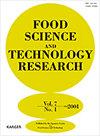Protective Effect of Zeaxanthin against Tunicamycin-induced Cell Damage in SH-SY5Y Cell
IF 0.9
4区 农林科学
Q4 FOOD SCIENCE & TECHNOLOGY
引用次数: 2
Abstract
Endoplasmic reticulum (ER) stress and the resulting neuronal cell damage have been implicated in the development and progression of Alzheimer’s disease. Tunicamycin (TM) induces ER stress in vitro, and the protective effects of the carotenoid zeaxanthin against the effects of TM have recently been studied. Zeaxanthin has been shown to hold several beneficial health properties in human studies. The protective role of zeaxanthin against the toxic effects of TM has recently been studied for the first time. The present study investigated whether zeaxanthin protects SH-SY5Y cells against TM-induced cell damage in vitro. Both pretreatment and post-treatment with zeaxanthin increased cell viability and suppressed lactate dehydrogenase release compared to levels in controls. Further, we found that zeaxanthin considerably ameliorated TM-induced cell damage by protecting the integrity of the mitochondrial membrane decreasing caspase-3 activity, and by reducing the apoptosis rate as well as the expression of the ER stress biomarker GRP78. Modulation of GRP78 may be one of the mechanisms by which zeaxanthin affects cell viability. Our results indicate a potential application of zeaxanthin in the development of new therapeutic drugs for the treatment of Alzheimer’s disease.玉米黄质对tunicamycin诱导的SH-SY5Y细胞损伤的保护作用
内质网(ER)应激和由此产生的神经元细胞损伤与阿尔茨海默病的发生和进展有关。Tunicamycin (TM)在体外诱导内质网应激,类胡萝卜素玉米黄质对TM的保护作用最近得到了研究。在人体研究中,玉米黄质已被证明具有几种有益健康的特性。近年来首次研究了玉米黄质对中药毒性的保护作用。本研究在体外研究玉米黄质是否能保护SH-SY5Y细胞免受tm诱导的细胞损伤。与对照组相比,玉米黄质预处理和后处理均提高了细胞活力,抑制了乳酸脱氢酶的释放。此外,我们发现玉米黄质通过保护线粒体膜的完整性、降低caspase-3活性、降低细胞凋亡率以及内质网应激生物标志物GRP78的表达,显著改善了tm诱导的细胞损伤。GRP78的调节可能是玉米黄质影响细胞活力的机制之一。我们的研究结果表明玉米黄质在开发治疗阿尔茨海默病的新药物方面具有潜在的应用前景。
本文章由计算机程序翻译,如有差异,请以英文原文为准。
求助全文
约1分钟内获得全文
求助全文
来源期刊

Food Science and Technology Research
工程技术-食品科技
CiteScore
1.40
自引率
0.00%
发文量
53
审稿时长
1.9 months
期刊介绍:
''Food Science and Technology Research'', published by the Japanese Society for Food Science and Technology, features reviews as well as original and technical articles on basic and applied food research.
 求助内容:
求助内容: 应助结果提醒方式:
应助结果提醒方式:


